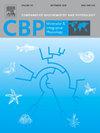Molecular characterization and function of sodium-dependent glucose transporter 1 in postprandial glucose homeostasis in Macrobrachium rosenbergii
IF 2.2
3区 生物学
Q4 BIOCHEMISTRY & MOLECULAR BIOLOGY
Comparative Biochemistry and Physiology A-Molecular & Integrative Physiology
Pub Date : 2025-02-05
DOI:10.1016/j.cbpa.2025.111822
引用次数: 0
Abstract
Aquatic animals often exhibit glucose intolerance following a glucose load, and understanding the mechanisms of glucose uptake is crucial for elucidating the underlying processes. Sodium-dependent glucose transporter 1 (SGLT1) plays a crucial role in the process of intestinal glucose absorption and transport in vertebrates, but there is limited information about its function in crustaceans. This study identified the SGLT1 gene (named MrSGLT1) from Macrobrachium rosenbergii. The full cDNA sequence is 3764 bp, encoding 903 amino acids. Unlike SGLT1 in most teleost fish, which have 14 transmembrane domains, MrSGLT1 protein has only 12. MrSGLT1 was predominantly expressed in the intestine, with its expression increasing after feeding. This was accompanied by elevated levels of glucose and trehalose in the hemolymph, and increased glycogen levels in the hepatopancreas. Silencing MrSGLT1 in vivo resulted in decreased glucose and trehalose levels in the hemolymph and reduced glycogen levels in the hepatopancreas, although muscle glycogen levels were unaffected. Moreover, knockdown of MrSGLT1 led to increased expression of genes involved in glycogenolysis and decreased expression of genes associated with glycogenesis, inhibiting postprandial glycogen accumulation in the hepatopancreas. Feeding-induced glycolysis was also inhibited following MrSGLT1 silencing, while no significant changes were observed in gluconeogenesis-related genes. These findings highlight the critical role of MrSGLT1 in regulating postprandial glucose homeostasis in crustaceans.

钠依赖性葡萄糖转运蛋白1在罗氏沼虾餐后葡萄糖稳态中的分子特征和功能
水生动物在葡萄糖负荷后经常表现出葡萄糖耐受不良,了解葡萄糖摄取的机制对于阐明潜在的过程至关重要。钠依赖性葡萄糖转运蛋白1 (Sodium-dependent glucose transporter 1, SGLT1)在脊椎动物肠道葡萄糖吸收和转运过程中起着至关重要的作用,但对其在甲壳类动物中的功能了解有限。本研究从罗氏沼虾中鉴定出SGLT1基因(命名为MrSGLT1)。全长3764bp,编码903个氨基酸。与大多数硬骨鱼中的SGLT1不同,它们有14个跨膜结构域,MrSGLT1蛋白只有12个。MrSGLT1主要在肠道中表达,饲喂后表达量增加。这伴随着血淋巴中葡萄糖和海藻糖水平升高,肝胰脏中糖原水平升高。体内沉默MrSGLT1导致血淋巴中葡萄糖和海藻糖水平降低,肝胰脏中糖原水平降低,但肌糖原水平未受影响。此外,MrSGLT1的敲低导致糖原分解相关基因的表达增加,糖原生成相关基因的表达减少,抑制餐后肝胰腺糖原积累。MrSGLT1沉默后,摄食诱导的糖酵解也被抑制,而糖异生相关基因未见明显变化。这些发现强调了MrSGLT1在调节甲壳类动物餐后葡萄糖稳态中的关键作用。
本文章由计算机程序翻译,如有差异,请以英文原文为准。
求助全文
约1分钟内获得全文
求助全文
来源期刊
CiteScore
5.00
自引率
4.30%
发文量
155
审稿时长
3 months
期刊介绍:
Part A: Molecular & Integrative Physiology of Comparative Biochemistry and Physiology. This journal covers molecular, cellular, integrative, and ecological physiology. Topics include bioenergetics, circulation, development, excretion, ion regulation, endocrinology, neurobiology, nutrition, respiration, and thermal biology. Study on regulatory mechanisms at any level of organization such as signal transduction and cellular interaction and control of behavior are also published.

 求助内容:
求助内容: 应助结果提醒方式:
应助结果提醒方式:


